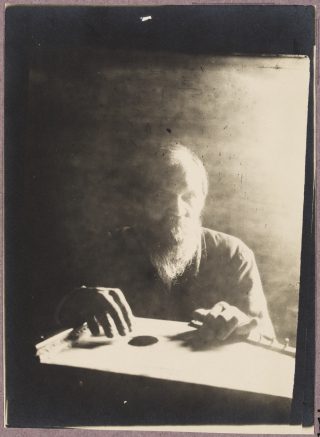Kantele of the Runosong Culture and the Dialogue of Creativity
Research
[This page is updated along the project]
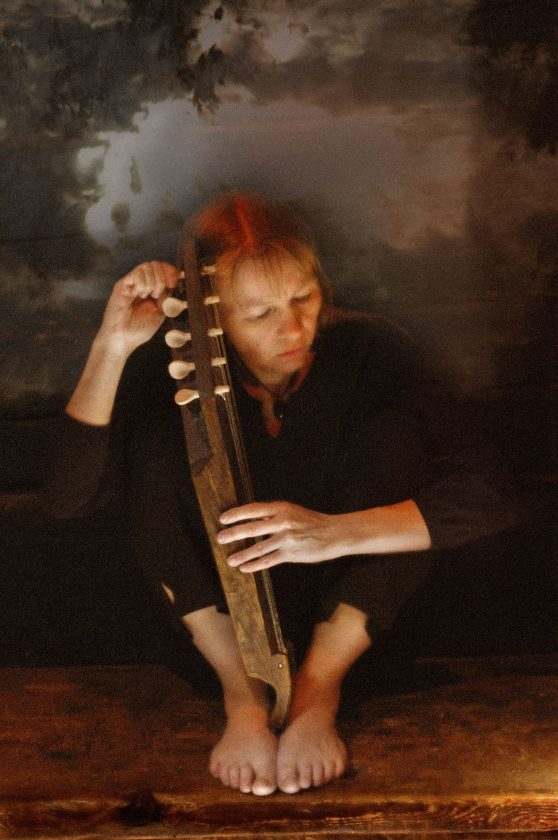
Photo: Paul Brück.
Kantele of the Runosong Culture and the Dialogue of Creativity is Arja Kastinen’s research project as a Visiting Researcher at the Sibelius Academy Folk Music Department, The University of the Arts Helsinki, from September 15, 2021 to July 31, 2026. The research is funded by the Finnish Cultural Foundation for three years from 2023.
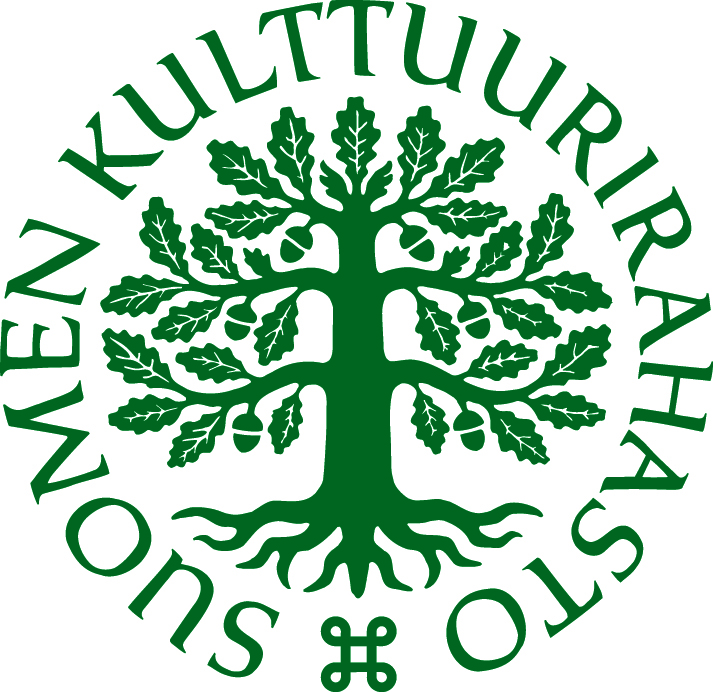
The Main Content of the Project
The project examines kantele improvisation within the Finnish-Karelian runosong culture, its various manifestations in its original context, and its possibilities and dimensions in modern times. This includes research into instruments, tunes, culture, history and improvisation.
Instrument Research
The study of the instruments includes examining the special features of the historical small kanteles: the influence of structure and materials on sound, tuning (pitch), playing technique and through them on music in different individuals of kantele instruments.
In connection with the study of the instrument and the music and aesthetics of ancient kantele improvisation,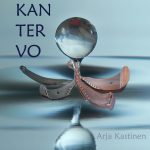 I released the album KANTERVO (TEMPS 08) on 5 November 2023, which contains new music with various copies of museum kantels. The album is digitally released and is available in most digital stores and streaming services.
I released the album KANTERVO (TEMPS 08) on 5 November 2023, which contains new music with various copies of museum kantels. The album is digitally released and is available in most digital stores and streaming services.
Recording: Arja Kastinen
Matering: Taito Hoffrén
Cover image: Tuomas Ylönen
EAN 6430032710006
ISRC FI9TE2300001–00010
Kantervo album was published on YouTube on Feb 2, 2024, with information about the instruments and music.
In 2023 started collaboration with Henna Tahvanainen, DSc(Tech), who, for example, has studied digital restoration of historical musical instruments at the Department of Industrial Engineering, University of Bologna.
Historical Finnish-Karelian small kanteles can be studied in Finnish museums, where there are several hundreds of them. However, you are not allowed to play musical instruments in museums, so the solution for researching sound is to get a copy from the instrument builder. With the help of replicas, musical instruments and the music produced with them can be approached in the means pretty much the same as in experimental archaeology.
In the video below, I present a 12-string hollow kantele – the so-called southern type as it is hollowed out from the top – made by Rauno Nieminen. This brass-string kantele was bought for the Perniö museum in 1906 from a famous runosinger Iivana Shemeikka (aka Jehkin Iivana) from Suistamo.
In the following video, I try out the effect of different brass and bronze wires compared to steel strings and tuning height on the sound of the Antero Vornanen‘s 5-string kantele from the 1930s.
In the next video, I explore the effect of gut strings on a 10-string kantele.
One of the special features of the topic is the study of resonance by spectral analysis. Both the old plucking technique and the tuning system of the instrument amplify the resonance, which in most kanteles is a very powerful and significant factor in the formation of musical tissue and the associated special sound field. A key question in improvisation is how this sound field and the resonance of free strings in turn affect the musician and the nature of the improvised music.
Resonance is also associated with the way Karelian kantele players of the 19th and early 20th centuries tuned their instruments using the first four partials of the harmonic series and often used scales resembling modes as the basis for their music. In addition, neutral thirds have been recorded from several players. These details have a significant impact on the music. The equal temperament scale is currently the most common among small kantele players due to its ease of use, but by it we lose something essential to the essence of this old kantele music.
Tune Research
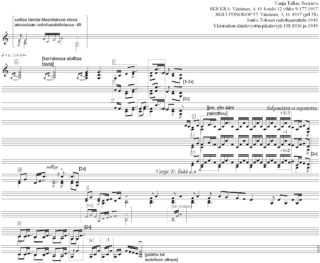 The study of old kantele tunes includes not only the study of runosong melodies, their variations and their adaptation on kanteles, but also the study of kantele tunes recorded at the turn of the 19th and 20th centuries. Although many of the recorded tunes represent a newer layer of music, the way they were played by old musicians is related to the musical aesthetics of the runosong culture and thus opens up perspectives on the past.
The study of old kantele tunes includes not only the study of runosong melodies, their variations and their adaptation on kanteles, but also the study of kantele tunes recorded at the turn of the 19th and 20th centuries. Although many of the recorded tunes represent a newer layer of music, the way they were played by old musicians is related to the musical aesthetics of the runosong culture and thus opens up perspectives on the past.
Research and analysis of copies of wax cylinder recordings at the beginning of the 20th century in the archives of the Finnish Literary Society, playing along with them and publishing them are currently underway. The first publication, Teppana Jänis, was released on February 28, 2021. The second publication, Iivana Mišukka, was released in February 2023 on Etno.net.
The third album is set to follow. It will contain the rest of the wax cylinder recordings of the Karelian kantele players in the archives of the Finnish Literature Society.
My related presentations:
- Motif-Centricity and Micro-Variation in Traditional Music symposium in Vienna, Austria, 9-12 Nov, 2022. Under the title Musician-researchers’ view on micro-variation in three different areas of Finnish and Finnic folk music as a three-member panel: Maari Kallberg, Piia Kleemola-Välimäki and Arja Kastinen.
- 14th Annual Conference of the Nineteenth Century Research Network in Helsinki on 18 January 2024. My paper: “Suomalaisen Kirjallisuuden Seuran arkistotallenteiden merkitys ja vaikutukset 1800-luvun karjalaisen kanteleimprovisaation moderneihin ilmentymiin 2000-luvulla” (The significance and impact of the wax cylinder recordings in the Finnish Literature Society’s archives on modern manifestations of 19th century Karelian kantele improvisation).
- Exploring Traditional Music on Wax Cylinders: Historical Technologies and Performance Styles, University of Surrey, Guildford, 12–13 June, 2024. My paper: ” Challenges and Insights – Wax Cylinders as a Tool for a Modern Musician’s Access to Music from an Ancient Tradition”. All presentations are available at the ERA’s YouTube-channel. My presentation is in session 4 (third presenter), Performance Practices:
Cultural and Historical Research
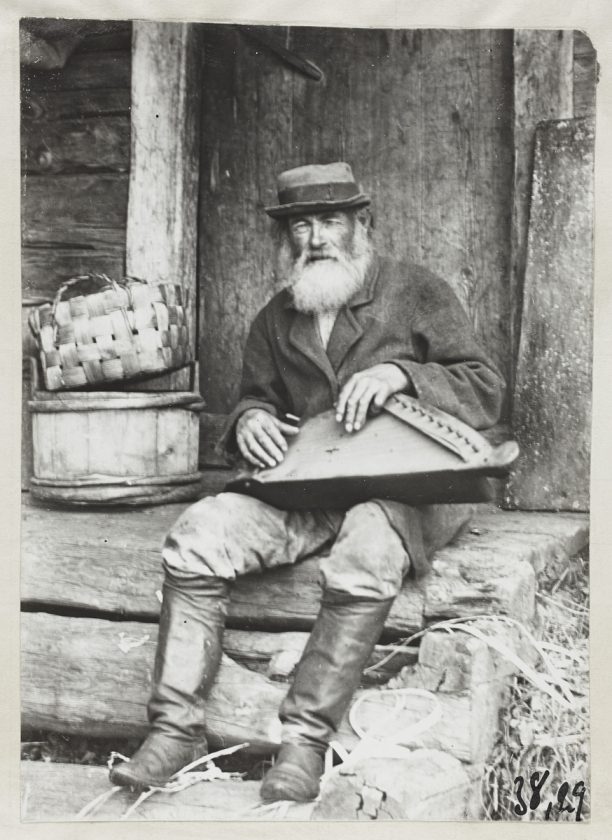
Pekko Shemeikka, Petri Shemeikan veli, soittaa kannelta_Samuli Paulaharju 1907_CC BY 4.0_ Museovirasto, Kansatieteen kuvakokoelma, Karjalaisen osakunnan kokoelma.
In this context, culture and history research includes combining the small kantele and its use with the world of illiterate people hundreds of years back. What was the significance of the instrument and the music in that culture? How did it manifest itself in everyday life? What was the influence of the people of the surrounding cultures on the transformation of the music? How is this particular way of making music inside the runosong culture positioned from a European perspective? How did this music change over time?
I try to answer these questions e.g. in the form of articles. The article (in Finnish) about Pedri Shemeikka’s heritage for musical culture from the perspective of a researcher-musician is published in the Musiikki-journal 1/2022.
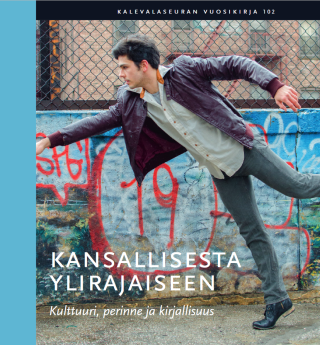 The peer-reviewed article Raja- ja aunuksenkarjalaisen kanteleimprovisaation ylirajaiset muodot pitkällä 1800-luvulla ja perinteen uudistunut jatkumo 2000-luvulla [The transnational forms of Border and Olonets Karelian kantele improvisation on the long 19th century and the renewed continuation of the tradition in the 21st century] is published in Kalevalaseura’s yearbook 102, Kansallisesta ylirajaiseen – Kulttuuri, perinne ja kirjallisuus [From National to Transnational – Culture, Tradition and Literature]. The research questions of the article are: 1) What cultural and historical phenomena have influenced the transnational development of the kantele tradition of the runosong culture over the centuries, especially in the areas of Border Karelia and Olonets Karelia? 2) What factors have influenced and continue to influence the process of the music’s emergence and the essence of the music? 3) How has this oral cultural tradition been transformed in the last 40 years or so into the creative musical expression of the modern world?
The peer-reviewed article Raja- ja aunuksenkarjalaisen kanteleimprovisaation ylirajaiset muodot pitkällä 1800-luvulla ja perinteen uudistunut jatkumo 2000-luvulla [The transnational forms of Border and Olonets Karelian kantele improvisation on the long 19th century and the renewed continuation of the tradition in the 21st century] is published in Kalevalaseura’s yearbook 102, Kansallisesta ylirajaiseen – Kulttuuri, perinne ja kirjallisuus [From National to Transnational – Culture, Tradition and Literature]. The research questions of the article are: 1) What cultural and historical phenomena have influenced the transnational development of the kantele tradition of the runosong culture over the centuries, especially in the areas of Border Karelia and Olonets Karelia? 2) What factors have influenced and continue to influence the process of the music’s emergence and the essence of the music? 3) How has this oral cultural tradition been transformed in the last 40 years or so into the creative musical expression of the modern world?
My presentations connected to the subject:
- The 19th Century Research Days at the University of Tampere, June 8-9, 2022. In my presentation, Peurankaataja Pedrin sielunmaisema, I depicted the 19th century Karelian kantele improvisation through one historical figure, Pedri Shemeikka.
- The History Research Days at the University of Tampere, October 20-22, 2022. I was part of the Social History Working Group on Music and Sound: Sound and Society. In my presentation, Valamon kellot, I examined the significance of the experience of the thunder of Valamo monastery church bells for pilgrims from the Border Karelia and its expression through their most important instrument, the kantele. An article on this topic is also in preparation.
- Music and Gender research days, January 23, 2023. My presentation with music examples: “Perinnesoittimen identiteetin muutos osana yhteiskunnan ja kulttuurin muutosta” [The change in the identity of the traditional instrument as part of the change in society and culture].
- The Baltic Psaltery Symposium in Kaunas, Lithuania, March 24–25, 2023. The title of my presentation was Kantele as part of the runosong culture in Border and Aunus Karelia in the 19th century.
- Kalevalaseura’s Kekri Seminar at the Finnish Literature Society, Helsinki, 31 October 2023. My paper: “Runolaulukulttuurin kanteleimprovisaatio ennen ja nyt” [Kantele Improvisation of the Runosong Culture Then and Now].
- A kantele-seminar at the folk music festival Sommelo 26 June, 2024.
Aesthetic Research and the Dialogue of Improvisation
The study of aesthetics has an impact on almost all aspects of this study. The aesthetics of small kantele improvisation in the runosong culture is special and in many respects different from current general music practices. Through that philosophy, I approach the question: how to create favourable conditions for an open and curious mind that allows creative improvisation?
One of the aims of the project is to develop ways to explore the dialogue that takes place within musical improvisation.
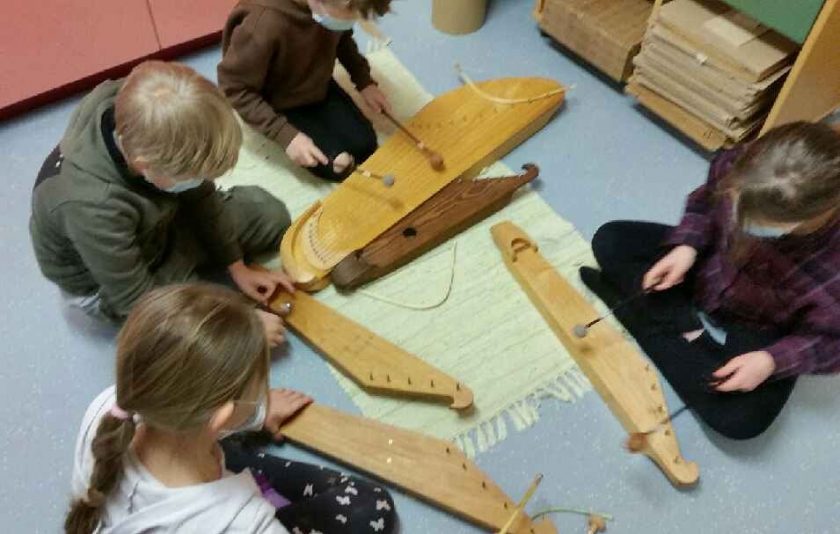
Improvisaatiotyöpaja Mika Waltarin koululla Laukkoskella 17.2.2022
Dialogue can be not only between different individuals but also internal. In line with that aesthetic, dialogue enables democratic and equal interaction. Things are looked at from different perspectives, different options are explored, and new, different and even surprising turns are considered with a curious attitude. The related exercises could be used for a wide range of education.
One of the research tools is workshops. In improvisation workshops for both adults and children, it is possible to explore the different possibilities and deeper meanings of the philosophy of that improvisation as part of creative activity.
Below is my first version of a creative dialogue diagram from the perspective of an improvising musician. It is based on the book Dialogi demokratiassa [ Dialogue in Democracy ] by philosopher Kai Alhanen.
Creative dialogue requires participants to have a common understanding of the key principles and practices that support the development of improvisation in the interaction between participants. The personal reaction of each individual becomes part of the whole, modifying it in its way. The goal is not a pre-agreed outcome, but the improvisation is allowed to proceed freely and participants should be given an equal opportunity to act.
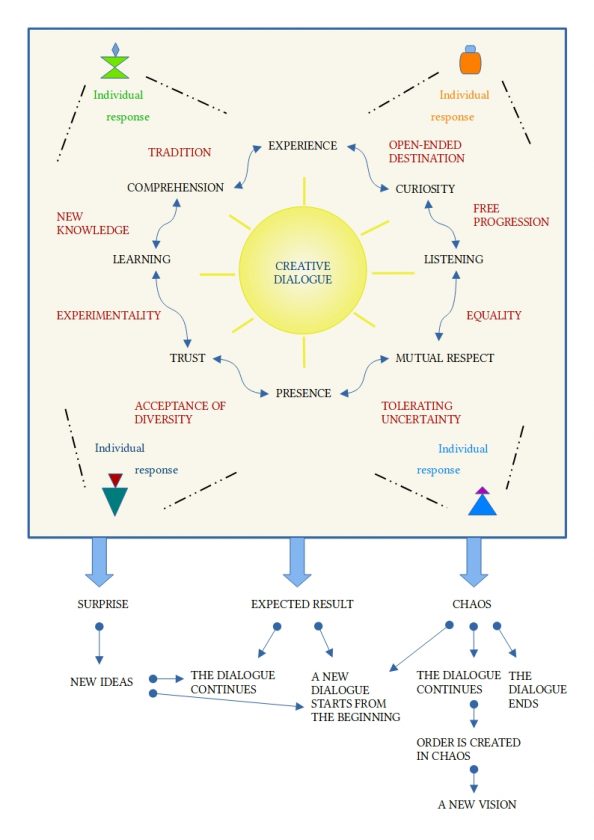
Effective improvisation requires participants to be able to listen and react, that is, to concentrate, to be genuinely present, and strive to understand different ways of performing. Communication is based on trust and mutual respect between group members, which in turn encourages participants to playful experimenting and diminishes the fear of failure.
The outcome of improvisation may be expected and unsurprising, which may lead to the continuation of the same dialogue or to the start of an entirely new improvisation. An unpredictable, surprising result can mean new ideas discovered through improvisation that could not have been imagined in advance. Improvisation can continue from this new perspective, or a new creative dialogue can be initiated inspired by the novel discovery.
The result of improvisation can also be chaos, which at worst leads to the end of the dialogue, the reluctance to continue to cooperate. Another possibility is to start over after the chaos by a joint decision – a new dialogue from the beginning.
The third option presented here to react to the chaos is to persevere in communicating despite the chaos. This is a path that I have often experienced as an almost integral part of the activity. After tenacious communication, order is created into chaos, and with this, an opportunity arises for the expansion of understanding and new insights. Tolerating uncertainty is one of the demands that improvisers have to internalize.
However, the most important thing in improvisation workshops is not the result (which is also often received with gratitude), but the process itself, which, if successful, strengthens the participants’ self-knowledge, empathy capacities, creative thinking, and collaboration skills.
Based on the same aesthetic-philosophical thinking, the inner dialogue of a musician working alone is based on the communication between the player and the instrument. This approach also encompasses several different courses of action, depending on the pedagogical objectives. For example, if the aim is to develop playing technique, improvisation exercises can be used to explore the importance of technique for the sound of notes and different timbres, and to play with the musical ideas generated by this technique. The relationship between the musician and the instrument, and the interaction that takes place within it, becomes central to the process.
The study of the aesthetics and philosophy of different folk music styles, combined with information about instruments, playing techniques, scales and tuning systems, deepens the student’s understanding of the meanings and possibilities of both past traditions and new music influenced by them.
The peer-reviewed article ”Kansansoittajat ja -laulajat kulttuurisesti kestävän ja kasvatuksellisen musiikin opetuksen suunnannäyttäjinä” written in collaboration with Vilma Timonen was published in the book “Musiikkikasvatus muutoksessa” (ed. Marja-Leena Juntunen and Heidi Partti), DocMus doctoral school publications 20, Sibelius Academy of the University of the Arts, Helsinki 2023.
My presentations connected to the subject:
- Orpheus Doctoral Conference Gent, Belgium 20–21 April, 2023: Before the sound: memory and the creative process. The title of my presentation: Past in present – Subconscious as the producer of a musical improvisation.
- Diversity of Music Heritage -conference, 8–9 June, 2023, Kaustinen, Finland. Together with Vilma Timonen we gave a presentation entitled Politics of Heritage Music in Formal Music Education: Runosong culture as a pathway to culturally sustainable education.
- Musiikintutkijoiden valtakunnallinen symposium 2024 Joensuu 25–27 March 2024 organized by the Finnish Ethnomusicology Society and the University of Eastern Finland. The title of my presentation: ”Runolaulukulttuurin kanteleimprovisaatio nykykansanmusiikissa” (The kantele improvisation of the runosong culture within the modern folk music).
Artistic Research
The strongest pillar of the whole project is artistic research under all the research subjects. Not only does it determine the angle of approach to the research questions, but it also involves the creation of new music, both from my own point of view and from a pedagogical point of view – that is, helping others to find their own way of creating improvisation based on this tradition.
In the following video, I play the 5-string kantele hollowed out from the top, made by Antero Vornanen in Varpakylä, Suojärvi, in the 1930’s. The music is improvised according to the aesthetics that we assume the kantele players of the Karelian runo song culture used when they said they were playing “their own power”.
The peer-reviewed exhibition Connected Alone – An Ancient Musical Culture as a Tool for Self-Expression Today was published in the journal of artistic research RUUKKU no. 18, Responsibility (30.9.2002). It contains 11 videos and texts in which I explore the aesthetics of kantele improvisation in runosong culture and its possibilities in modern times, not only as a means of self-expression for musicians, but also as a means of music education.
The song “Kantervo kalan evästä” from the album KANTERVO is featured in the video below. In the video I play a 12-string vaskikantele (made by Rauno Nieminen from a kantele bought for the Perniö Museum from Iivana Shemeikka in 1906) and a modified 15-string model called the Korpiselkä kantele (made by Keijo Säteri). The music was composed in collaboration with percussionist Oskari Lehtonen.
In the video I play a 12-string vaskikantele (made by Rauno Nieminen from a kantele bought for the Perniö Museum from Iivana Shemeikka in 1906) and a modified 15-string model called the Korpiselkä kantele (made by Keijo Säteri). The music was composed in collaboration with percussionist Oskari Lehtonen.
Part of the artistic research was to organise a concert that would look at the improvisation being studied from the point of view of the listener. It would also explore the involvement of the audience in the making of the music, thus creating a dialogue.
The first concert of this kind was prepared by three Kanteletupa workshops in which the possibilities of small kantele improvisation were studied. The action of the creative dialogue was based on the diagram above.
The first Kanteletupa concert was organised by Pauliina Syrjälä, Eva Väljaots and me at the Helsinki Musiikkitalo on 11 February 2023 in Organo. After the concert, there was a short feedback discussion and written feedback was also collected from the audience. Below you will find a short video clip of the concert.
The Kanteletupa project will be the subject of a research article in the future.
As a continuation of the Kanteletupa, a three-day workshop on creative small kantele music was held in June 2023 at the beautiful Kallio-Kuninkala site in Järvenpää.
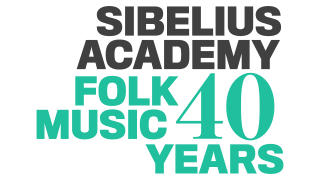 On 5 November 2023 I hold a kantele improvisation event with Professor Emeritus of Folk Music Heikki Laitinen at the Helsinki Central Library Oodi Maijansali Hall from 13:00 to 16:00. This event was part of the SibA Folk 40th Anniversary Jubilee Events Series.
On 5 November 2023 I hold a kantele improvisation event with Professor Emeritus of Folk Music Heikki Laitinen at the Helsinki Central Library Oodi Maijansali Hall from 13:00 to 16:00. This event was part of the SibA Folk 40th Anniversary Jubilee Events Series.
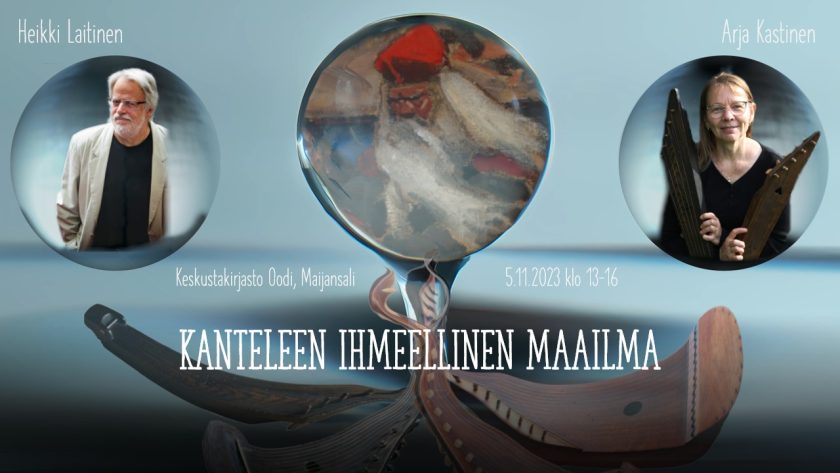
Together with Kirsi Ojala we organized a Kanteletupa concert at Näsi Manor on Friday 8 December.
I gave a concert with kantele replica presentations at the “Ullakko” in Tuupovaara March 24, 2024.

